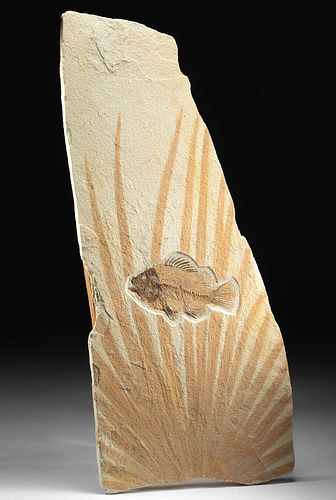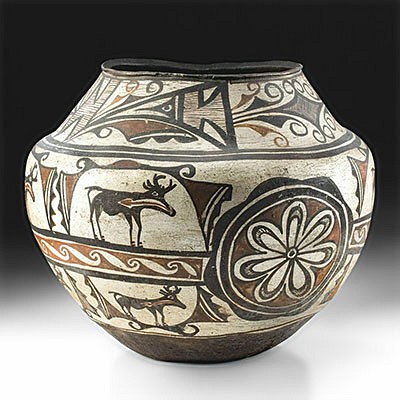Rare Complete Fossilized Priscacara Fish & Palm Fronds
Lot 109
About Seller
Artemis Gallery
686 S Taylor Ave, Ste 106
Louisville, CO 80027
United States
Selling antiquities, ancient and ethnographic art online since 1993, Artemis Gallery specializes in Classical Antiquities (Egyptian, Greek, Roman, Near Eastern), Asian, Pre-Columbian, African / Tribal / Oceanographic art. Our extensive inventory includes pottery, stone, metal, wood, glass and textil...Read more
Estimate:
$2,000 - $3,000
Absentee vs Live bid
Two ways to bid:
- Leave a max absentee bid and the platform will bid on your behalf up to your maximum bid during the live auction.
- Bid live during the auction and your bids will be submitted real-time to the auctioneer.
Bid Increments
| Price | Bid Increment |
|---|---|
| $0 | $25 |
| $300 | $50 |
| $1,000 | $100 |
| $2,000 | $250 |
| $5,000 | $500 |
| $10,000 | $1,000 |
| $20,000 | $2,500 |
| $50,000 | $5,000 |
| $100,000 | $10,000 |
| $200,000 | $20,000 |
About Auction
By Artemis Gallery
Nov 18, 2021
Set Reminder
2021-11-18 10:00:00
2021-11-18 10:00:00
America/New_York
Bidsquare
Bidsquare : Art & Artifacts of North America
https://www.bidsquare.com/auctions/artemis-gallery/art-artifacts-of-north-america-7894
Join us for a special auction not to be missed! Collectible Native American art from antiquity to mid-20th century, Spanish Colonial, Latin American, Pre-Columbian, fine & folk art, American frontier items, fossils, and much more! Artemis Gallery info@artemisgallery.com
Join us for a special auction not to be missed! Collectible Native American art from antiquity to mid-20th century, Spanish Colonial, Latin American, Pre-Columbian, fine & folk art, American frontier items, fossils, and much more! Artemis Gallery info@artemisgallery.com
- Lot Description
North America, Wyoming, Green River Formation, Eocene Period, ca. 53.5 to 48.5 million years ago. Wow! This is an amazing and sizable sandstone matrix that contains a fossilized palm frond and a Priscacara serrata fish! This species of prehistoric fish was once numerous, and their fossilized remains are often referred to by fossil hunters as "prisky" - since they are related to perch and have prickly dorsal spines. This fish is slightly recessed in the matrix and was carefully excavated to preserve the bones and soft tissue. Prisky was predatory, with rounded teeth for eating crustaceans and small fish, and lived in a subtropical lake, surrounded by flowering plants and trees - including palms, as evidenced by the frond in the matrix! The sediment from the Green River Formation was deposited over a 5-million-year span, the layers of flora and fauna may not have fossilized at the same time - but make for interesting composites. The complete fish in the foreground and fronds splayed out behind is impressive! Size: 31.5" L x 14.25" W x 1.75" H (80 cm x 36.2 cm x 4.4 cm)
Provenance: private Berthoud, Colorado, USA collection
All items legal to buy/sell under U.S. Statute covering cultural patrimony Code 2600, CHAPTER 14, and are guaranteed to be as described or your money back.
A Certificate of Authenticity will accompany all winning bids.
PLEASE NOTE: Due to recent increases of shipments being seized by Australian & German customs (even for items with pre-UNESCO provenance), we will no longer ship most antiquities and ancient Chinese art to Australia & Germany. For categories of items that are acceptable to ship to Australia or Germany, please contact us directly or work with your local customs brokerage firm.
Display stands not described as included/custom in the item description are for photography purposes only and will not be included with the item upon shipping.
#167930Losses to sandstone matrix and chips as shown. Mounted on a wooden frame for support with a metal bracket for mounting on a wall. Having both the complete fish and most of the frond in such a naturally pleasing arrangement is quite rare!Condition
- Shipping Info
-
All shipping is handled in-house for your convenience. Your invoice from Artemis Gallery will include shipping calculation instructions. If in doubt, please inquire BEFORE bidding for estimated shipping costs for individual items.
-
- Buyer's Premium



 EUR
EUR CAD
CAD AUD
AUD GBP
GBP MXN
MXN HKD
HKD CNY
CNY MYR
MYR SEK
SEK SGD
SGD CHF
CHF THB
THB














